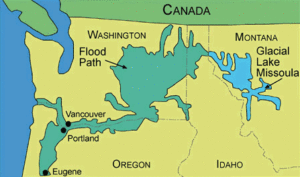Eurasia
Lake Missoula

Lake Missoula was an enormous glacial lake in the American northwest, which was formed as the last Ice Age was ending. It periodically discharged into the Pacific Ocean, reshaping the landscape and in the process creating what is now confirmed to have been the largest waterfall in the world(a).
In the 1920s a maverick geologist, J Harlen Bretz (1882-1981), postulated that a huge ice-age flood had carved the landscape of Eastern Washington state, in just a few days. In spite of acrimonious opposition from the geology establishment of the day, Bretz persevered with his investigations which eventually led to the identification of Lake Missoula as the probable culprit. Bretz was finally vindicated in 1979 when, in his nineties, he was awarded the prestigious Penrose Medal for his work(b). Although Bretz’s ideas eventually received a level of acceptance, there is still controversy surrounding some details of his theory(d).
>In 2022, a report published by the US National Academy of Sciences “showed how the changing weight of the ice sheets would have caused the entire landscape to tilt, changing the course of the megafloods.”(g)<
It has been estimated that Glacial Lake Missoula was as big as Lakes Erie and Ontario combined(f). However, Missoula should not be seen in isolation but considered along with the even more extensive lakes created in Eurasia, following the last Ice Age and the collapse of ice dams. The extent of these lakes has been studied and reported on by Ronnie Gallagher(e).
There is now a website dedicated to the Lake Missoula floods(c)
(a) https://www.bbc.com/travel/story/20170601-the-largest-waterfall-that-ever-existed
(b) http://www.detectingdesign.com/harlenbretz.html
(c) GLACIAL LAKE MISSOULA – Home (archive.org) *
(d) https://www.oregonlive.com/news/2010/02/geologists_find_a_way_to_simul.html
(e) https://grahamhancock.com/gallagherr1/
(f) Explore Glacial Lake Missoula | Montana Natural History Center (montananaturalist.org)
(g) Earth Tilt and the Missoula Megafloods – ATLANTIS RISING THE RESEARCH REPORT *
Ice Dams
Ice Dams were not uncommon following the ending of the last Ice Age. Glacial Lake Missoula in North West America has been estimated to have burst out every fifty years or so over a two-thousand-year period between 13,000 and 11,000 BC. These events are dealt with in detail by David Alt in his Glacial Lake Missoula[846]. Lake Agassiz was another enormous lake formed by glacial run-off after the last Ice Age and at its maximum extent was larger than any lake existing in the world today. There is evidence that Lake Agassiz like Missoula also breached ice dams from time to time, discharging into the Atlantic. Another large and frequent breaching of ice dams occurred in the Siberian Altai Mountains(d)(e). A USGS report listing the largest of these events is available online(b).
Recent reports(g)(h)(i) claim that around 6200 BC the bursting of an ice dam in Canada released the meltwater contents of Lake Agassiz and Lake Ojibway into the North Atlantic that resulting in Greenland being cooled by an average of 7.4ºC and Europe by about 1ºC and raising the global sea level by between one and three metres (3-10 feet).
Equally dramatic was the extent of the flooding in Eurasia following the collapse of north Asian ice dams. Ronnie Gallagher has an interesting article about this on Graham Hancock’s website(a). Gallagher favours a Eurasian location for Atlantis.
In a 1975 report, Cesare Emiliani and others at the University of Miami supported the idea that the flooding resulting from bursting ice dams at the end of the Last Ice Age may have been the reason for the ubiquity of ancient flood myths, such as the biblical Deluge(l)(m).
Even today the retreating glaciers in the Himalayas have created lakes that threaten a number of Nepalese villages. Similar conditions exist in Peru, where some years ago a flood from glacial Lake Palcacocha killed an estimated 5,000 people(j). In 2004, another ice dam attached to the Perito Moreno glacier in Argentina also collapsed, watched by applauding tourists(k).
Professor Neil Glasser from Aberystwyth University is the lead author of a report published in 2016 in Scientific Reports, in which the breaching of an ice dam in South America, between 11,000 and 6,000 BC, was on such a scale that it altered the circulation of the Pacific Ocean. Glasser noted(f) that: “This was a massive lake. When it drained, it released around 1150km3 of freshwater from the melting glaciers into the Atlantic and Pacific oceans – equivalent to around 600 million Olympic-sized swimming pools. This had a considerable impact on the Pacific Ocean circulation and regional climate at the time.”
(a) https://www.grahamhancock.com/forum/GallagherR1.php
(d) https://www.lpi.usra.edu/meetings/lpsc2002/pdf/1110.pdf
(f) https://phys.org/news/2016-02-catastrophic-failure-ice-age-ocean.html
(g) Science – Dec. 22, 2000
(h) Proceedingsof the National Academyof Sciences – DOI:10.1073/pnas.0510095103]
(i) Quaternary Science Reviews –vol 25, p 63]
(j) National Geographic, December 2019, p.138
(l) https://www.nytimes.com/1975/09/24/archives/surge-of-ice-sheets-water-into-mississippi-said-to-support-deluge.html (subscribers only) or see Archive 7185 | (atlantipedia.ie)*
